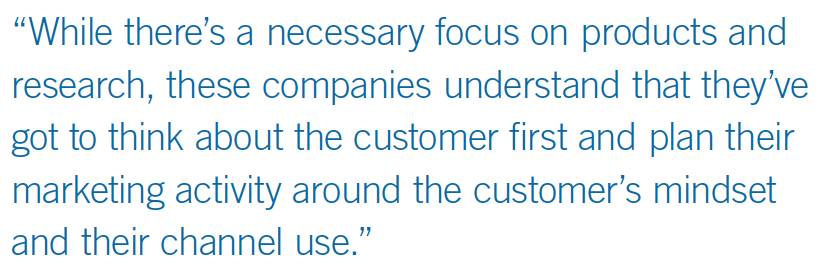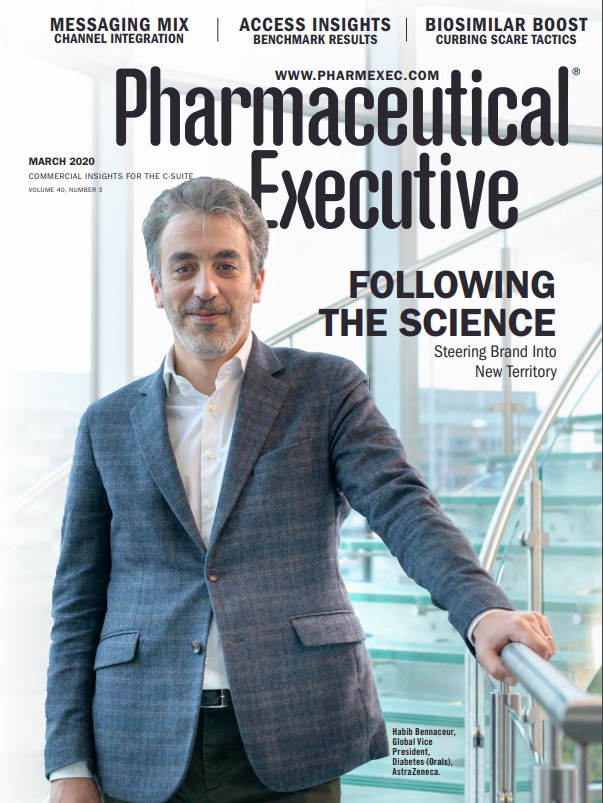The Multichannel Reach: Balancing the Local and Global Voice
Pharmaceutical Executive
Exploring the challenge for pharma in adapting multichannel marketing strategies for the global stage, while trying to refine messages and communicate a brand identity to multiple local audiences.
The challenge for pharma in adapting multichannel marketing strategies for the global stage, while trying to refine messages and communicate a brand identity to multiple local audiences
In today’s fast-evolving digital world, a pharma company faces plenty of challenges in maximizing the value and impact of its multichannel marketing strategy. The formidable rise of the digital-savvy, empowered patient, for example, has disrupted the hierarchies of the industry-physician-patient communication dynamic; the growing complexity of safety requirements, increasing drug recalls, and the push for greater transparency has led to more wastage of marketing assets when they fail to clear compliance hurdles; and with many pharma companies spending about 40% more on marketing than on research (according to market activation company Tag), spiraling costs are an ongoing concern-Tag reports seeing marketing-content wastage of up to 30%.
In adapting multichannel marketing strategies for the global stage, while trying to refine messages for multiple local markets, the industry encounters further obstacles. Not only are domestic concerns much amplified-a company with a global marketing spend of $2 billion stands to lose tens of millions a year just on content wastage, for example-but the task of navigating a wealth of varying cultural sensitivities, codes of conduct, and national laws also comes into play.
Understanding how to communicate a brand identity and new products successfully at both a global and local level is a complex process. As Tag observed last year, “Most companies can’t justify the time and resources needed to conduct grass-roots-level research every time a brand wants to launch a product in a new country.” But defining a global strategy and refining it to local audiences is vital to a company’s success, Tag went on, “not only for [its] customers … but also for the supply chain that will support it.”1
While “think global, act local” has long been established as a marketing mantra for multinational companies, ironically, it can be harder to achieve in this era of faster worldwide communication. “The media is more complex than it used to be,” Tag’s managing director for client services, Kevin Spicer, told Pharm

Exec. “The use of data to drive marketing is more complex. And those things vary by market, so today you’ve got to be supersmart about the ecosystem, the digital channels, and the technology in each market.”
Spicer believes, however, that “it is absolutely possible to strike the right balance between global consistency and local tailoring.” The companies that are doing this well are those that understand the need for strategic-level partners, according to Spicer. “They tend to have established partnerships that allow them to face the challenges around global consistency, economies of scale, and suitability for a particular market or culture across creative media and production,” he says. “While there’s a necessary focus on products and research, these companies understand that they’ve got to think about the customer first and plan their marketing activity around the customer’s mindset and their channel use.”
Strategy and technology
One firm that has been striking the right balance between the global and local voice is Danish drugmaker Lundbeck. Lundbeck’s digital strategy has moved toward using one platform for all its channels. As the company’s head of global digital platforms and analytics, Vicky Lalumiere, outlined last year, “This is essential for us at global HQ and [for] our affiliates… When we think of either reps or websites or social media, it all comes down to one platform and one way of driving our content.”2
This isn’t just a matter of a technical platform but of “having a coherent and overarching communications strategy within our culture and among our affiliates,” Lundbeck’s vice president of global customer engagement, Danilo Pagano, told Pharm Exec. “What we do on a daily basis is to try to establish-at a local level in Europe, in Asia, and the Americas-a solid and robust content strategy around disease awareness,
Danilo Pagano

around Lundbeck’s focus on improved brain health in patients, and on improved medical knowledge around brain health.”
Previously, Lundbeck’s global marketing strategy was more fragmented, says Pagano. “Every affiliate was in charge of its local strategy, without any global tools.” So, two years ago the company moved to a common platform, a common digital space, “where we can place our content and where affiliates can pick and choose the content they want to use-in line with local regulations and restrictions- and then translate, adapt, and publish that content,” he explains. “From a technical perspective, it is a big digital repository; from a communications strategy perspective, it is about having one single voice, for example, when it comes to fighting the stigma around depression or providing more information on how to deal with a schizophrenic patient.”
While a coherent communications policy and truly collaborative working culture are crucial factors in the successful rollout of a multichannel marketing strategy, the underpinning technology has, not surprisingly, been growing in importance. The companies at the “mature end” of the global-multichannel-marketing curve are ones that are “aware of the need to invest in digital and technology,” observes Spicer. Their partnerships and internal marketing functions will be working well, but they also understand the need for a technology engine underneath, “whether that’s asset management systems, workflow systems, or audience management to allow them to connect through data,” he says.
Mirroring its ubiquity elsewhere in the industry, artificial intelligence (AI) is making its presence felt in this arena. “We’re seeing AI starting to understand how to interpret an instruction from a user to find assets that could be relevant for a brief,” says Spicer. “One subset of the very big area of AI case-use is in content production. There are pieces of software that allow you to press a button and seconds later you’ve got 150 adapts, so the role of armies of people creating adaptations of master artwork is becoming less and less. This can lead to savings in cost and weeks of work potentially.”
Lundbeck is venturing into AI with the use of chatbots. The chatbot on Lundbeck’s online psychiatry and neurology resource center, Progress in Mind, offers “a new way to interact with healthcare professionals (HCPs),” explains Pagano. “HCPs can interact with it as if they’re having a natural conversation.”
The chatbot can provide them with information such as the latest study on depression or news from the latest Schizophrenia International Research Society (SIRS) conference, for example. “As it is powered by machine learning technology, the chatbot ‘learns by doing,’ so its ability to interact in a natural way with customers improves with every conversation,” he says.
For some of Lundbeck’s patients themselves, Pagano adds, AI can have advantages over human interaction. “Schizophrenic patients can be paranoid, and they can actually feel more comfortable dealing with a machine than a human,” he says. We’ll see far more human-to-machine interaction in the brain health space in the future, Pagano believes. Already, in China, where there is a major shortfall of general practitioners, AI is being used via “remote consultations” to drive patients to specialists.
Regions and responses
Becoming more sophisticated in translating its multichannel strategies between global and local regions has seen pharma broaden its understanding of cultural sensitivities in markets around the world. Regional differences in the way HCPs consume and engage with messages remain a major consideration in developing a global strategy. As Tag noted in its blog last year, there is still “huge variation in uptake and attitudes among physicians in different parts of the world,” for example.
The blog pointed to IQVIA data from March 2017, which found that “94% of Japan’s specialist physicians felt their preferred amount of digital communication was being achieved,” whereas this figure was just 50% in the US and 17% in the UK. It added: “In Italy and Germany, all doctors surveyed were dissatisfied, saying they wanted more digital activity, and a faster move away from the traditional modes of communication.”3
For Spicer, however, success can depend more on the client than the region, and on where the client is on the maturity curve. “It depends on how open and ready they are, on how much technology they’ve already got in place, rather than it being about the market.” China, however, is “an outlier for us,” he says. “Where a lot

of other global strategic partners are Western-run, China has its own ecosystem.” It can be a challenging place to execute a multichannel marketing strategy. There can be a cultural disconnect between how a multinational company works and the need to have presence and ability in China. Says Spicer, “Does the global company really understand the Chinese digital ecosystem and all the different social platforms and technologies there? How does it grapple with heavy regulation? How does it deal with needs and local relationships at a government level?”
Pagano agrees that China presents a unique challenge, but he says the country “is a source of inspiration for us because it is moving into the digital realm so fast.”
While Lundbeck is establishing a common content strategy, how that content is best delivered varies slightly across different regions; different social media channels are favored locally. In China, Lundbeck uses the WeChat platform to engage and promote disease awareness among customers; the company is also experimenting with and piloting projects where information is delivered through other digital channels, such as QR Codes, which are widely used in China. Elsewhere, in Brazil for example, WhatsApp is a preferred mode of communication. In South Korea, it is KakaoTalk. In Italy and Spain, it’s Facebook.
Striking the balance
While, for Pagano, “social media offers the best way to raise disease awareness and fight social stigma”-Lundbeck, accordingly, spends “a massive amount of time designing and building content that is digestible on social media”-it is important not to lose sight of some of the more traditional channels that can still be

effective. Says Spicer: “I think the demise of television was somewhat overexaggerated, as was the demise of print. Both are doing pretty well, frankly. Conventional media can still do a lot that digital cannot; it’s about keeping that balance, retaining what works and finding new solutions.”
Ultimately, it comes down to a company’s structure and culture and “how far people are able and willing to collaborate,” adds Spicer. “It’s not just the work around setting up the technology. It’s the people and processes around the systems that you need to get right. You need to retrain and reshape the culture around the solution.”
Julian Upton is Pharm Exec’s European and Online Editor. He can be reached at jupton@mmhgroup.com
References
1. “Global vs local: how to navigate tough challenges in pharma marketing,” www.tagww.com, March 25, 2019.
2. “Lundbeck’s digital strategy and how they manage global and local content,” pharmaphorum.com, October 15, 2019.
3. “Global vs local,”www.tagww.com

The Misinformation Maze: Navigating Public Health in the Digital Age
March 11th 2025Jennifer Butler, chief commercial officer of Pleio, discusses misinformation's threat to public health, where patients are turning for trustworthy health information, the industry's pivot to peer-to-patient strategies to educate patients, and more.
Navigating Distrust: Pharma in the Age of Social Media
February 18th 2025Ian Baer, Founder and CEO of Sooth, discusses how the growing distrust in social media will impact industry marketing strategies and the relationships between pharmaceutical companies and the patients they aim to serve. He also explains dark social, how to combat misinformation, closing the trust gap, and more.